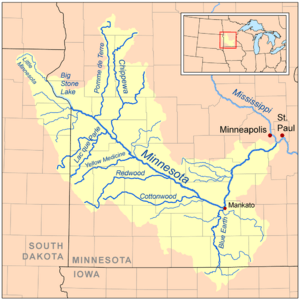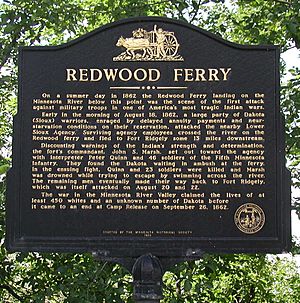Battle of Redwood Ferry facts for kids
The Battle of Redwood Ferry was a fight that happened on August 18, 1862. It was the very first day of the Dakota War of 1862, a big conflict in Minnesota. This battle was a tough start for the United States soldiers involved.
Quick facts for kids Battle of Redwood Ferry |
|||||||
|---|---|---|---|---|---|---|---|
| Part of The Dakota War of 1862 | |||||||
 Minnesotariver map |
|||||||
|
|||||||
| Belligerents | |||||||
| Dakota (Santee Sioux) | |||||||
| Commanders and leaders | |||||||
| White Dog |
Captain John S. Marsh† | ||||||
| Units involved | |||||||
| Unknown | Co B, 5th Minnesota Infantry, Fort Ridgely | ||||||
| Strength | |||||||
| Unknown (more than 47) | 47 | ||||||
| Casualties and losses | |||||||
| Unknown (1 confirmed) | 24 killed, 1 drowned, 5 wounded | ||||||
Contents
How the Battle Started
On the morning of August 18, 1862, news reached Fort Ridgely about an attack at the Lower Sioux Agency. Captain John S. Marsh heard from people who had escaped that Dakota warriors were attacking settlers. More refugees arrived, confirming the serious situation.
Captain Marsh quickly decided to help. He sent a message to Lieutenant Timothy Sheehan, asking him to return to the fort with his soldiers right away.
Within 30 minutes, Captain Marsh left Fort Ridgely. He took 46 soldiers from Company B of the 5th Minnesota Infantry Regiment and an interpreter named Peter Quinn. Marsh and Quinn rode mules, while the other soldiers marched. Later, wagons caught up, and the soldiers rode in them.
Meanwhile, 19-year-old Lieutenant Thomas P. Gere was left in charge of Fort Ridgely. He had only 22 soldiers ready for duty. Other people at the fort helped him manage the many refugees arriving.
On their way, Captain Marsh and his soldiers met many settlers running away. One person, Reverend Samuel D. Hinman, warned Marsh that the attacks were very serious. He said Marsh and his men would be greatly outnumbered.
Six miles from Fort Ridgely, Marsh and his men saw burning houses. They also saw many people who had been killed along the road. Captain Marsh kept going toward Redwood Ferry, determined to stop the attacks.
General Lucius Frederick Hubbard later wrote that Captain Marsh still hoped it was just a small group causing trouble. He was confident he could stop it and hurried his soldiers forward.
The Battle at Redwood Ferry
What exactly happened at Redwood Ferry is not fully clear. In the end, Captain John S. Marsh drowned, 24 soldiers were killed, and five were wounded.
About three miles from the Lower Sioux Agency, Marsh and his men reached Faribault Hill. They left their wagons behind and walked toward the ferry house. This house was near the ferry landing on the east side of the Minnesota River.
The area near the landing was covered in thick grass and bushes. Many Dakota warriors were hiding there, ready with their guns.
Marsh and his men reached the ferry house around noon. They found the ferryboat conveniently waiting there. Survivors later thought the Dakota might have wanted them to get on the boat, where they would have been easy targets. The soldiers had already found the dead ferryman on the road.
White Dog's Actions
Across the river, the soldiers saw White Dog (Śuŋkaska). He was a Dakota leader. They also saw some Dakota women and children. John Magner, a soldier who knew White Dog, said White Dog was holding a large tomahawk and had red paint on his face. Red paint often meant a warrior was ready to fight.
Captain Marsh talked with White Dog through his interpreter, Quinn. White Dog said he did not plan to fight and that there would be no trouble.
White Dog then invited Marsh to cross the river for a meeting. White Dog himself later confirmed this at his trial after the war.
Some people later said White Dog purposely talked for a long time. This would have given other Dakota warriors time to cross the river upstream. They could then hide and take control of the ferry house. Soldier John Magner reported seeing many Dakota warriors in the river and in the weeds. Marsh then told his men to go back.
White Dog then seemed to give a signal for the Dakota warriors to shoot. Twelve soldiers and the interpreter, Quinn, were killed right away.
Before his trial, White Dog told Reverend Stephen Return Riggs that he saw the warriors waiting to attack and gestured to Marsh to stay back. White Dog also said he did not tell the warriors to fire. He felt he did not get a chance to tell his full story. However, most other accounts disagree with White Dog's version of events.
The Fight Begins
Marsh and his men did not try to cross the river. Suddenly, a single shot was fired. The Dakota warriors jumped out from the bushes and trees where they were hidden. Quinn and twelve soldiers were killed. Marsh's mule was also killed. Marsh gathered his remaining men to fire back at the warriors who had taken over the ferry house. They then moved to the Faribault cabin.
Escape Attempt
With enemies on three sides, Marsh led his men along a thick area of bushes downstream. When they reached the end of the bushes, they saw Dakota warriors blocking their way back to the fort.
Marsh decided their only choice was to cross the river. He led his men into the water. Marsh was a strong swimmer, but he got a cramp and drowned in the strong current. The Dakota warriors seemed to think Marsh and the remaining 16 men had crossed successfully. They then hid, ready to ambush them again.
After the Battle
The message sent by McLean reached Lieutenant Sheehan. Sheehan and his Company C returned to help defend Fort Ridgely.
The soldiers who survived the battle made their way back to Fort Ridgely. As it got dark, Lieutenant Bishop sent two soldiers, James Dunn and William B. Hutchinson, to the fort to tell the commander what had happened. They arrived at Fort Ridgely at 10:00 PM. The rest of the surviving soldiers returned to the fort on August 20.


